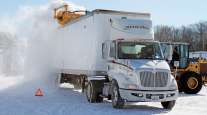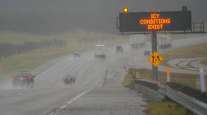Special to Transport Topics
Winter Preparedness for Fleets Starts Long Before the Cold Arrives

[Stay on top of transportation news: Get TTNews in your inbox.]
As seasons change and temperatures drop, the unpredictability of winter is the only certainty facing truck drivers whose routes can run headfirst into a blizzard. As preparedness is the best defense against the rough elements, winterizing vehicles is an essential part of maintenance and safety.
Most fleets usually start the preparation in September or early October. Ideally, winterization should start at the beginning of the season; however, it’s a process that should continue throughout the winter months.
“As soon as you stop using the air conditioning, that is the time to start winterizing the vehicle. That will change year to year,” said Dennis Davis, safety supervisor at Prime Inc., adding that the fleet starts discussing winterization around Labor Day.

For the coming winter, emergency kit recommendations include jumper cables; fuel additives; and a lighted extension cord to plug in electric block heaters to help keep the engine warm. (Prime Inc.)
Prime Inc. is ranked No. 18 on the Transport Topics Top 100 list of the largest for-hire carriers in North America.
Most fleets provide driver safety training year-round, though it is particularly important as winter approaches.
Nathan Smith, senior vice president of equipment and properties at J.B. Hunt, is responsible for all maintenance at all its facilities across the country, which includes more than 18,000 company-owned tractors and 139,000 trailing units.
J.B. Hunt ranks No. 4 on the TT 100.
“Every week we send messages out to drivers to tell them little tips,” said Smith. “We have a maintenance tip every week; we start reminding them that winter is coming and to make sure they have the proper gear in their trucks.”
He noted driver education is an important component to the fleet’s safety training. Drivers are encouraged to conscientiously improve on their training and know, for example, how the block heater works, or how and when to put additives into the fuel to prevent gelling.
Smith said it is also imperative that the drivers have the proper gear to prepare for any situation on the road. For the driver’s personal safety and comfort, this includes warm clothes; a blanket; hat, gloves and scarves; food and water; and a fully charged cellphone battery. For the truck itself, he recommended jumper cables; fuel additives; lighted extension cord to plug in electric block heaters to help keep the engine warm; good wiper blades; an ice scraper; and salt and ice melt.

During the winter, tires lose pressure as temperatures drop and rolling resistance increases. Elements such as rain, snow and slush all increase tire rolling resistance. (J.B. Hunt)
“We have a fleet support team of over 150 people who are just dealing with breakdown situations for a driver, 24/7, with the goal of responding to any driver in under a minute and 10 seconds,” said Smith. “We check back with drivers every 30 minutes to make sure they’re in good shape and let them know when help is on the way and give them updates. We don’t want anyone left out in a winter situation without a lifeline.”
Besides 20- to 25-foot jumper cables, Prime’s Davis recommended a high-quality flashlight, insulated footwear, a fridge stocked with food and water, as well as nonscented kitty litter to provide traction in emergencies. At Prime, all drivers have 24-hour access to a maintenance adviser while on the road and the company offers a professional maintenance class for drivers.
Matt Trites, senior director of maintenance at Day & Ross, headquartered in Hartland, New Brunswick, says in addition to the driver, preparing a truck properly for the elements is crucial for their safety as well as other drivers on the road. “We live and breathe preventative maintenance,” he said.
Day & Ross ranks No. 31 on the TT 100.

Preparing a truck properly for the elements is crucial for driver safety as well as other on the road. (Day & Ross)
Trites recommends drivers install fresh wiper blades for the season and be sure to have a spare when on the road. With new technology and features in today’s units, basic items such as wipers get overlooked, but with the changing seasons, it’s always a good time to ensure they are properly working.
“If there is the slightest bit of cracking or wear, it is a good idea to change the blades. You will need those in the wintertime to remove snow and ice from the windshield,” Trites said. “If you can’t see clearly out your windshield, that puts you in a very, very hazardous place.”
Most maintenance professionals agree that truck batteries need to be in good working order and need to be holding a charge; batteries are prone to freezing when they are not fully charged, and the stress of the extreme cold can cause batteries to lose much of their strength. The driver may crank the ignition a few more times than usual to start the engine, which draws energy from the battery. Thus, before winter sets in, the batteries should be performance tested and all the connections secure. Also, tires have to be in good working order and in good condition.
“Tires have to be a good tread depth; we recommend an aggressive tread with respect to traction; a good traction tire that has a good amount of tread still left on the tire is imperative for traveling in the winter on snowy roads,” Trites said.
Though most trucks have hydraulic brakes, others are equipped with air brakes. Those brakes are accompanied by air tanks that hold the compressed air that is needed to activate the air brakes. They can often gather liquid condensation and need to be drained.
Ideally, drivers should drain their air tanks to remove liquid condensation year-round, but in the winter, it is even more important — otherwise, the liquid condensation will turn to ice. Trites recommends doing this daily.
“Yes, it’s a chore, but it is much easier to crawl underneath and drain tanks as opposed to sitting on the side of the road because it froze up,” he said.
Matt Wiedmeyer, director of fleet services for Fleet Advantage, said that adverse weather costs the trucking industry north of $3.5 billion each year.
“Fuel economy and truck performance can be challenging, especially in the winter for several reasons. Winter diesel contains less paraffin wax to prevent gelling [paraffin is the source of British thermal units],” he said. “Cooler ambient temperatures decrease engine efficiency and increase aerodynamic drag [a 10-degree Fahrenheit drop equals a 2% increase in aero drag]. Tires lose pressure as temperatures drop and rolling resistance increases. Furthermore, rain, snow and slush all increase tire rolling resistance.”
Wiedmeyer also noted that cold water significantly cools tires, as well as transmission and rear axle lubricants. This results in a decrease of 0.2 to 0.3 miles per gallon, according to the Society of Automotive Engineers. Headwinds/crosswinds also impact mpg (10 mph wind equals a 13% drop in mpg).
“Additionally, trucks usually experience increased idle time and decreased use of cruise control during the winter, resulting in further drops in fuel economy,” Wiedmeyer said.

Due to pandemic-related shortages, some fleets have worked with third parties, such as TrucBrush, to work on winter maintenance. (TrucBrush)
Pandemic-related shortages in the industry are everywhere, which is why some companies are contracting with third parties to work on winter maintenance. Day & Ross, uses a hybrid model — a combination of in-house technicians and third-party, but even before the pandemic, the company had been utilizing side vendors, as, with 3,800 trucks in the fleet, it was too large of a job to do it all in-house. Similarly, maintenance is generally 85% in-house at J.B. Hunt.
Smith noted the key is to prepare early, watch your weather, make sure you have the proper tools and supplies in the truck and take your time to make sure your truck is ready to go.
“On the safety side, the driver will be the ultimate decision-maker,” he said. “If it’s not safe, I don’t want him or her out on the road, even if they have the best equipment.”
Prime’s Davis said that first and foremost, drivers need to take care of themselves.
“We don’t win at operating in inclement weather. We have nothing to gain, no trophy at the other end, no extra pay or incentive if you persevere,” he said. “The only thing you have out there is a risk of an accident.”
Want more news? Listen to today's daily briefing below or go here for more info:




